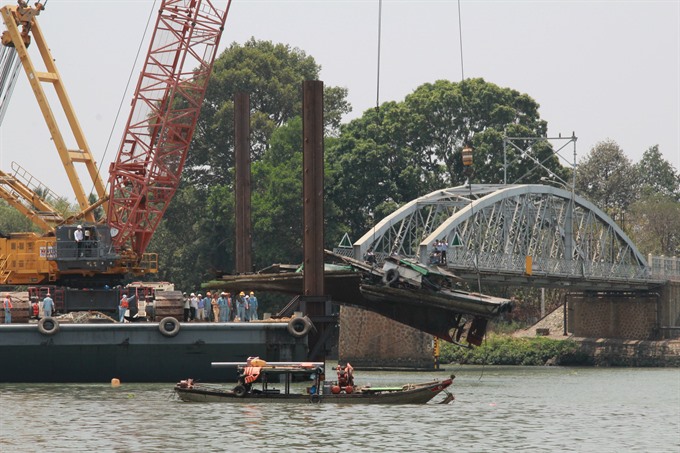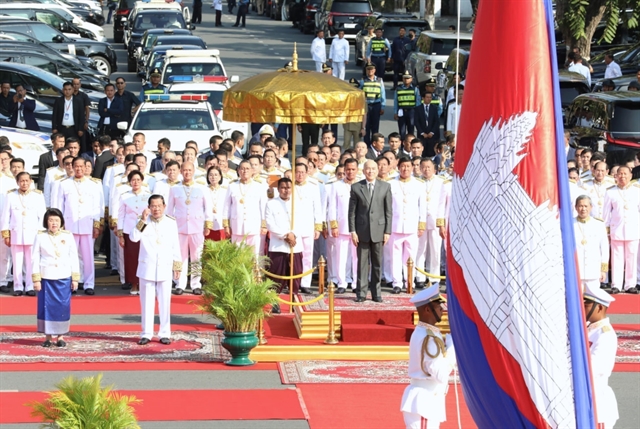 Society
Society

The country’s struggling rail transport sector continues to falter, with output and revenues of Việt Nam Railways (VNR) declining considerably, falling short of set targets.
 |
| Ghềnh Bridge collapse in Đồng Nai Province disrupted the North-South railway for three months, dealing a significant blow to the already flagging sector. - VNA/VNS Photo Sỹ Tuyên |
HÀ NỘI – The country’s struggling rail transport sector continues to falter, with output and revenues of Việt Nam Railways (VNR) declining considerably, falling short of set targets.
Đoàn Duy Hoạch, Deputy Director of the Việt Nam Railways (VNR), made the announcements on Thursday during the state-owned operator’s conference on its business plan for 2017.
The rail transport sector’s revenue of VNĐ 8.338 trillion (US$367.6 million), was only 88.8 per cent of the target. Post-tax profit was estimated at VNĐ 137 billion ($6.04 million), while on-schedule train arrival hit 98.5 per cent.
The corporation has carried out divestment in 30 companies worth VNĐ 204.3 billion ($9 million), bringing back VNĐ 404.91 billion (nearly $18 million) – two times the investment value.
From 2014 to 2016, the corporation laid off nearly 11,000 personnel.
Outdated railway infrastructure and insufficient quality of services were blamed for the sector’s disappointing performance and failure to catch up with other modes of transport by Hoạch.
“Mounting competition with other modes of transport, the Ghềnh Bridge collapse in Đồng Nai District, sea environment pollution, and storms and floods in the Central region all adversely impacted the corporation’s business. In addition, limited budget for infrastructure development for 2016 delayed the implementation of new projects,” he said.
Nguyễn Ngọc Đông, Deputy Minister of Transportation – also in charge of the VNR’s Board of Directors – said that last year, railway infrastructure didn’t enjoy many upgrades, but restructuring which is expected to rejuvenate its business is scheduled for 2017.
Đông agreed with Hoạch, saying that the Ghềnh Bridge collapse in last year’s March severely disrupted the North-South Railway for three months, affecting both roadway and railway.
VNR’s attempts to “renew its mindset” still haven’t met the market’s demands, thus the unsatisfactory results of measures – evidenced by uncompetitive railway prices and unattractive services.
This year, the corporation aims for growth of eight per cent or higher in revenues, post-tax profits of VNĐ 138 billion ($6.08 million), 5-7 per cent cuts in railway accidents compared to 2016.
The corporation’s plans to promote its competitiveness, expand railway market share, increase revenues from passenger and freight transportation, find new partners to invest in railway systems and other support facilities like warehouses, freight yard, loading and offloading sites. Automatic barriers on level-crossing will also be installed.
According to Đông, the budget for railway this year stands at VNĐ 2.2-2.3 trillion ($97 million – 101 million). For mid-term capitals, the Ministry of Transport has requested more funding from the state budget for upgrading infrastructure and resolving the sector’s bottlenecks.
“The competition the railway sector has to face will just increase, since growth potential for other transport sectors such as airway, waterway, and road transport remains large,” he said.
“Therefore, the sector must maintain steady activities, aiming for the maximum use of existing infrastructure, ensuring traffic safety. Steady means not trailing behind,” Đông stressed.
Đông also requested VNR to focus on better organisation of transport activities, on implementing new technologies and on the efficient management of existing infrastructure.
VNR is devising a project for specialisation of freight and passenger transport, and a project to improve operating capacity on the country’s railway system, especially the Hà Nội – Vinh route. – VNS



